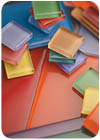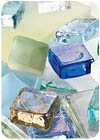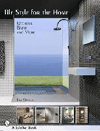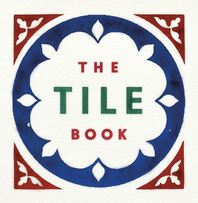
While today’s sophisticated glass tile designs add a decidedly modern flair to any space, the use of glass tile dates back to ancient times. New technology is emerging to enhance the appearance, functionality and durability of glass tile; however, much of the tile used in design today is still manufactured by employing time-tested, centuries-old production techniques.
As with any design element, color is key; and the addition of color to glass is a crucial element to the manufacturing of glass tile. In their recent book, “Glass Tile Inspirations for Kitchens and Baths,” Patricia Hart McMillan and Katharine Kaye McMillan, PhD, outline three basic and centuries-old techniques for making and adding color to clear glass: Cast glass, enameled glass and fused glass.

Cast Glass
Cast glass is created using an ancient Egyptian technique in which coloring agents are added to molten glass, which is then pressed into the shape of the glass tiles. This process allows the color to permeate the body of the tile, maintaining the translucent and reflective quality of glass, while preventing fading or degradation. An example of such translucent cast glass is Crossville’s Illuminessence series. Manufactured in an Ottawa, IL, glass factory dating to the 19th century, Illuminessence is crafted in such a manner to promote maximum reflectivity and movement, giving an overall appearance of light on water.Enameled Glass
While some manufacturing companies now employ mass production methods to create enameled glass tiles that appear handmade, the book’s authors note that many manufacturers still employ the generations-old method of hand painting the back side of glass to ensure handcrafted appeal. Special precautions must be taken when installing this type of glass to prevent degradation of color and de-lamination.Fused Glass
With its nearly unlimited options for size and color, fused glass is among the most versatile glass tiles on the market today. While no exact date has been documented for the first use of fused glass, many experts cite its primitive use in ancient Egypt, while more advanced fusing techniques were employed by Roman glassmakers.
Writing on Aboutglasstile.com, John Dumbrille explains that fused glass tiles are made from float glass -- or intact sheets of glass -- that are fired in kilns at high temperatures. Modern fused glass production often entails stacking layers of thin glass to create patterns and designs. Crossville’s Venetian Glass, for example, is created by fusing three layers of glass together, with the middle layer being an intricate, hand-blown Italian Murano glass. A more basic utilization of fused glass tile techniques involves adding color under the glass, which is clear, allowing a layer of opaque color to show through. This technique is used to create Crossville’s latest glass introduction, Glass Blox, as well as its Brilliante series. Ranging in size from small mosaics to large-format, fused glass tile is offered by numerous glass tile manufacturers, and is one of the most popular types of glass currently available.
Etched Glass
A variation of fused glass is etched glass, which Dumbrille describes as fused glass with a thin, but translucent surface layer, which allows light to pass through the surface layer and reflect back into the room, imparting a warm “backlit” appearance that Dumbrille likens to LCD lighting. Etching is achieved using one of three methods -- abrasion, acid etching or through the application of an additional cloudy glass surface to the top of the tile. Glasstains and Jaspers, by Interstyle Ceramic and Glass Tile, are illustrative of the etched glass manufacturing technique.Slumped Glass
As demand arises for more decorative glass tile options, manufacturers are offering slumped glass tiles, like Interstyle’s Glassforms. Using the slumped glass technique, tiles are created by heating glass to a temperature that allows it to be melted into relief molds. When the glass cools, it retains the curves and contours of the mold.
No matter what manufacturing technique is employed -- from the ancient to the emergent -- today’s glass tile products offer the versatility, durability and practicality, not to mention the color, shapes, textures and fashion-forward styling contemporary spaces demand. As so eloquently stated in the introduction to “Glass Tile Inspirations for Kitchens and Baths,” many other materials offer high performance and functionality, but none other can bring a room to life by “dancing with the light.”



